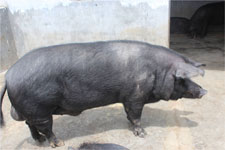Benefit of Rearing Jharsuk Pig
JHARSUK’ was developed by AICRP on Pig, BAU, Ranchi. It has superiority in various economic traits over desi pigs. It was developed by crossing Tamworth, a British pig and local one having 50% inheritances of both, thereafter inter-se-mating and by continuous selection for several generations on the basis of black colour, faster growth and better reproductive performances. The variety can gain approximately 80 kg body weight at slaughter age of 8-10 months. It can produce 8-12 piglets in each farrowing with two farrowing each year. This variety has widely been validated in farmers’ field.Jahrsuk variety was developed under All India Coordinated Research Project on Pig at Birsa Agricultural University, Ranchi. It was developed by crossing Tamworth and local pigs of Jharkhand with 50% inheritances of both, thereafter inter-se-mating and by continuous selection for several generations on the basis of black colour, faster growth and better reproductive performances. The variety can gain approximately 80 kg body weight at slaughter age of 8-10 months. It can produce 8-12 piglets in each farrowing with two farrowing each year. This variety has widely been validated in farmers’ field.
Important economic traits:


Litter size at birth: 7-8 piglets
Weight at 8 months of age: 70-75 kg
India possesses one of the largest livestock populations in the world which has a crucial role in rural economy and livelihoods of the majority of the Indians residing in rural areas . About 20.5 million people depend upon livestock for their livelihood. Livestock contributed 16% to the income of small farm households as against an average of 14% for all rural households. Livestock provides livelihood to two-third of rural community. It also provides employment to about 8.8% of the population in India. India has vast livestock resources. Livestock sector contributes 4.11% GDP and 25.6% of total Agriculture GDP. Among the different livestock species, pigs are believed to be the most prolific and remunerative livestock species. Sakthivel and Narmatha (2019) reported that in India, pig raising and pork industry are run mostly by traditional pig farmers belonging to the lowest social – economic stratum and particularly in the states under the study viz. Jharkhand, Chhattisgarh, West Bengal and Bihar, the majority of pig farmers were tribals and scheduled castes. There were three different genetic groups of pigs available in all the four states under the study. They were Jharsuk Pig, Pure and Cross breeds of Large White Yorkshire, Nondescript pigs and Ghungro pig breed (in West Bengal only). Across eastern region of India, Jharsuk Pig was one of the most preferred and commonly found livelihood option chosen by schedule castes, schedule tribes and other weaker sections of the society (Seth 2012) . This section of the society could be a potential target for making suitable interventions to promote pig farming in the given area. Though piggery was commonly practiced in these states, there was a great demand of basic and scientific manage mental techniques along with proper and sustainable veterinary services in rural areas? These needs could be taken care of if need based intervention are designed and implemented in the given area. Keeping in view the profitability, premium market price and acceptability of Jharsuk pigs among pig farmers of eastern India, piggery development interventions were initiated by various government and non-governmental agencies with special reference to new pig breed i.e. Jharsuk pig, for the livelihood security and income generation through self-employment. The Government of Jharkhand initiated the interventions to promote pig husbandry as a viable subsidiary source of income of rural population by providing improved facilities of cross breeding, replacement of local pigs with piglets of Jharsuk pig breed produced in Government farm. Jharkhand livestock breeding policy-2011 initiated the pig development and breeding policy for Jharkhand state. In this policy, local pigs shall be crossed or upgraded with Jharsuk pig breed. Birsa Agricultural University had also made efforts for diffusion and dissemination of information on Jharsuk pigs through various projects and programmes viz. AICRP, Mega Seed Project, Mission Mode on Pig, IVLP, FLD and training programme on pig husbandry. As per the mandate, KVKs (Birsa Agricultural University) had distributed Jharsuk pigs among farmers of 24 adopted villages every year under Front Line Demonstration (FLD) programme. Jharkhand Sukar Palak Sahyog Samiti has created in order to bring the pig growers at one platform. The society has published four issues of newsletters named “Sukar Palan Samachar”. Radio Kisan Club was another feature of Sukar Palak Sahyog Samiti, which had broadcasted sponsored episodes on pig breeding and management through Radio station, Ranchi and all the episodes were sponsored by members of Sukar Palak Sahyog Samiti. Similarly, West Bengal, Chhattisgarh and Bihar initiated piggery development interventions with specific attention on Jharsuk pig innovation. The Jharsuk pigs were distributed through various programmes viz. RKVY, ATMA and FLD in West Bengal. For instance, KVK, Sonamukhi, Bankura (West Bengal) had distributed Jharsuk piglets among farmers of adopted villages of KVK, Sonamukhi. The Government of Chhattisgarh has distributed 150 Jharsuk pigs under TRIOS programmes during the year 2003-2004. Whereas, 4000 male pigs and 4000 pigs were given to TRIOS during 2010-2011, out of these, 1000 pigs were of Jharsuk breed. Further, viewing the demand and acceptability of Jharsuk pigs among the farmers of Jashpur (Chhattisgarh), Department of Animal Husbandry, Government of Chhattisgarh had established a Jharsuk pig farm with 125 stock size at Kunkuri block of district Jashpur in 2011, which had targeted to produce 1000 Jharsuk piglets in each year to fulfill the demand of pig farmers and livelihood security through the pig enterprise. The above mentioned development oriented programmes implemented in the states under the study might have helped in the diffusion and adoption of the Jharsuk pig innovation, since, it was observed that the Jharsuk pigs were increasingly being embraced by the pig farmers replacing desi stock in all the states selected in this study.
Backyard PIG Rearing Practices in India

Backyard PIG Rearing Practices in India
Compiled & Shared by- Team, LITD (Livestock Institute of Training & Development)
Image-Courtesy-Google
Reference-On Request.


